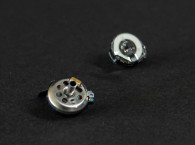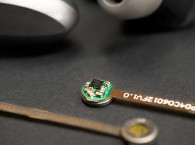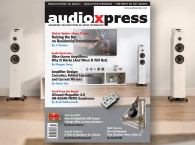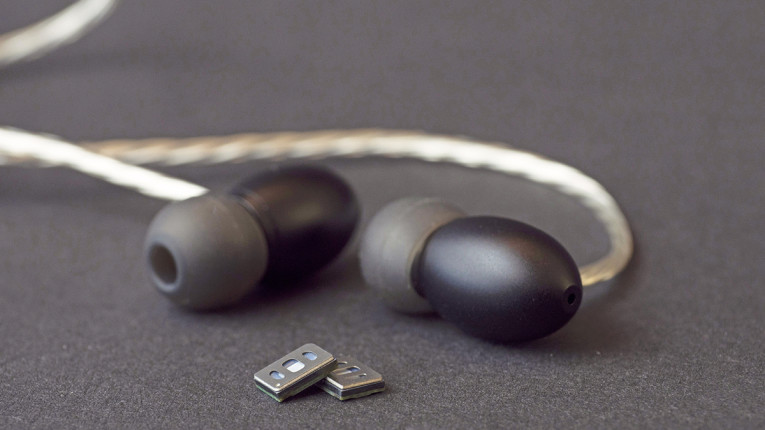
However, MEMS speakers seem suited for applications that don’t require high sound pressure level (SPL), such as earphones. Considering how popular balanced armatures — another technology that struggles to produce high SPLs — have become in hearing aids and higher-end earphones, MEMS speakers would certainly have a chance in applications where balanced armatures are currently used. That’s exactly what USound, an Austrian start-up focused on MEMS technology, is attempting to demonstrate with the Megaclite 4.0 UH-R2040, a reference-design earphone with one USound Achelous UT-P2018 driver per earpiece.
MEMS offers a few potential advantages over balanced armatures and dynamic drivers. The packages are slim. The Achelous UT-P2018 speaker measures just 6.7mm × 4.7mm × 1.58mm, comparable in length and width to smaller balanced armatures, but thinner (Photo 1). They’re surface-mount technology (SMT) reflow-compatible, so easy to incorporate into automatic assembly processes. The piezoelectric drivers generate no magnetic field and minimal heat.
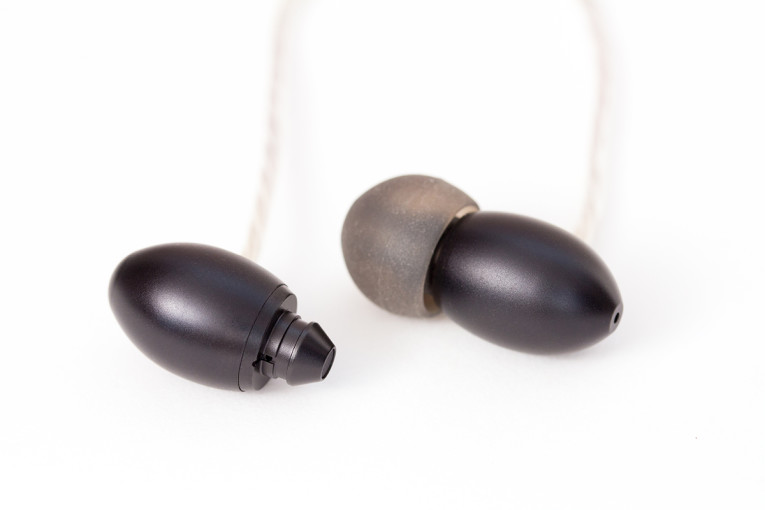
MEMS drivers can also be waterproof to a degree that challenges balanced armatures and dynamic drivers — USound’s Conamara drivers carry an IPX8 water-resistance rating, which means they can be continuously immersed in 1 meter or more of water, and USound rates them for up to 30 minutes’ immersion in 3 meters of water. (Currently, the most water-resistant earphones I’ve seen carry an IPX7 rating, which means they can be immersed in up to 1 meter of water for at least 30 minutes.)
For the most part, USound’s performance claims aren’t extraordinary. The Achelous UT-P2018 is rated for full-bandwidth applications, and USound’s published driver specs show measurable response up to 40kHz. Maximum SPL is rated as 117dB at 1kHz, although that’s with a 15V peak drive signal. Sensitivity is rated as 94dB at 1kHz with a 1Vrms signal; this low sensitivity, combined with the driver’s need for a bias voltage, eliminates the possibility of passive applications.
When I found out about the Megaclite, I was eager to hear it. I’ve heard a few earphones that attempted to go beyond dynamic drivers and balanced armatures — specifically, with miniaturized planar-magnetic, electrostatic, and air-motion transformer drivers — but only one or two that, in my opinion, matched or exceeded the performance of conventional drivers. Considering that USound makes no extraordinary performance claims for its MEMS speakers, the bar was set pretty low — to succeed, the Megaclite merely had to deliver performance comparable to that of an ordinary earphone.
The Product
Looking at the Megaclite, you’d never guess that it incorporates a new and potentially revolutionary technology. From the outside (Photo 2), it’s not much different from standard dynamic-driver earphones. The aluminum enclosures measure 12mm in diameter and 21mm long, terminating in a 6mm sound tube for which USound includes silicone tips in three sizes. The cable leg for the right channel incorporates an inline microphone/remote.
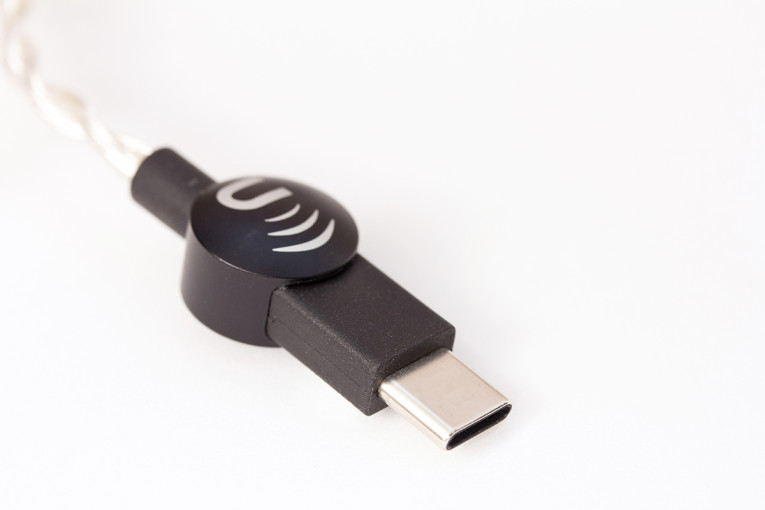
The source end of the cable incorporates a USB-C dongle (Photo 3) with an internal DAC, amplifier and drive electronics. The active design of the Megaclite prevented me from doing some standard measurements, including driver input impedance and sensitivity, but otherwise, I was able to use the Megaclite just as I’d use a set of passive earphones plugged into a USB-compatible DAC-amplifier, such as one of AudioQuest’s DragonFly series.

I used the Megaclite with my Samsung Galaxy S10 smartphone and my Lenovo Ideapad Flex 5-1470 laptop, which has a USB-C jack. The earphones fit me just like typical dynamic-driver earphones, although as often happens when I review earphones, my extra-large ear canals required that I use SpinFit XL-size silicone tips to get a tight seal.
Listening
I compared the Megaclite with two sets of earphones: the $199 Campfire Audio Satsuma, which uses a single balanced armature; and the dynamic-drive AKG earphones (model number unspecified) that came with my Samsung Galaxy S10 phone. Unfortunately, the AKGs were the only dynamic-driver passive earphones I had on hand, because these days, almost all the earphones I review are high-end, multiple-driver types with balanced armatures, or true wireless models. (That’s a reflection of where the high-end and mass markets are going, and not necessarily indicative of a preference on my part.)
One thing I noticed right away is that the Megaclite’s maximum volume was a little on the low side — not so low that I couldn’t enjoy listening to them with most recordings, but with conservatively mastered music recordings that have a relatively low average level, I often found myself wanting 2dB or 3dB more volume. I’ll address this in depth in the Measurements section.
When I played my all-time-favorite tonal balance test, Tracy Chapman’s “Fast Car,” through all three sets of earphones, it quickly became clear that the sound of the MEMS drivers was well within the norms of currently available earphones. Bass and treble both had extension comparable to what I heard from the other earphones. The balance of bass to midrange to treble was fairly similar with all three — the Megaclite and the AKG sounded very close, while the Satsuma sounded like it had a couple decibels more overall treble output than the others.
I heard no undue emphasis or muting of specific frequency bands, although the Megaclite’s lower treble sounded a little coarser than that of the AKG and Campfire models, sometimes making Chapman’s voice sound a little congested, as if she was suffering a mild cold. I heard the same vocal coloration when I played Holly Cole’s version of “Good Time Charlie’s Got the Blues.” However, I’ve heard similar colorations with dynamic-driver earphones, and I imagine it could easily be fixed through acoustical tuning or DSP. It’s important to note that AKG and Campfire Audio have extensive experience in tuning earphones, and devote considerable time to the process. It’s hard to imagine a MEMS device company equaling their efforts.
Through a few weeks of regular listening, I didn’t develop any major complaints about the Megaclite earphones—and for a reference design that’s created merely as a proof of concept rather than a finished consumer product, that’s pretty good.
Measurements
I performed measurements using a GRAS RA0402 high-resolution ear simulator/coupler (Photo 4). I used my Audiomatica CLIO 12 QC to feed signals to the Megaclite through my laptop’s USB-C jack, and to analyze the signals coming off the RA0402 coupler. For volume (SPL) measurements, I used the RA0402 with an M-Audio Mobile Pre USB interface running Room EQ Wizard software.

After hearing how the Megaclite seemed relatively limited in maximum output, I measured its maximum output the same way I measure the maximum volume of kids’ headphones for Wirecutter.com — I played pink noise at a level of -10dBFS, and measured the A-weighted output with the measured diffuse-field response of the RA0402 coupler subtracted. This test gave me a result of 90.2dBA SPL. To put this in perspective, active kids’ headphones are (in theory, at least) limited to 85dB SPL, which is considered a reasonably safe level for 8 hours of daily exposure. For most adult listeners, 85dB will sound somewhat quiet.
Despite my reasonably careful listening habits (which have resulted in only average hearing loss for my age and gender, despite having played in lots of bands and making a living in the audio business for 30-plus years), maxing out at 90dB sometimes left me wanting a little more volume. USound’s ratings suggest the drivers can take a lot more juice, but whether typical amp chips found in true wireless earphones can deliver that much power, I can’t say without being able to test the Megaclite’s drivers and amp separately.
For me, one of the joys of evaluating new technologies is seeing strange new things appear in the frequency response plots, and having to figure out what’s going on. Sadly — or happily, depending on how you look at it — the Megaclite robbed me of this experience. Looking at the frequency response in Figure 1 without knowing what was measured, I’d never guess that the earphones use a new technology. I see two unusual characteristics. One is a single, very broad rise in the treble, between about 2 and 8kHz. With most earphones, we’d see two separate resonant peaks, one centered at 2 or 3kHz, and another centered at 7 or 8kHz. The other is a very high-Q peak centered at 19.5kHz — something I’ve never before seen in an earphone measurement. Both anomalies could be fixed with EQ. The latter would be audible to extremely few (if any) listeners.

Figure 2 shows how the Megaclite’s response compares with a couple of commercially available single-driver earphones: the Campfire Audio Comet (predecessor to the Satsuma), which uses a single balanced armature; and the Technics EAH-TZ700, which uses a single dynamic driver. I also threw in the AKG N5005, a hybrid design with a single dynamic driver and four balanced armatures, because it’s the passive earphone that’s said to come closest to the so-called “Harman curve,” the frequency response found in Harman International research to correspond best with average listener preference.

Again, there’s nothing really unusual about the Megaclite’s response. It does show a little excess energy in the upper bass/lower midrange region, around 150Hz to 400Hz, but that was a common characteristic of earphones before the Harman curve started to have an influence. I assume it can be fixed through acoustical tuning or the addition of a dynamic driver to cover the bass frequencies — something commonly added to balanced armatures.
Figure 3 shows the Megaclite’s total harmonic distortion vs. frequency at a level of 90dBA (measured with pink noise) and 95dBA. Normally, I run these measurements at 90dBA and 100dBA. I chose these levels not because they are typical — they’re actually much louder than most listeners would like — but because they straddle the typical break-up point for most headphones and earphones. Most I’ve tested can play at 90dBA with negligible distortion, but quite a few average 4% or 5% total harmonic distortion (THD), or even higher, at 100dBA. However, the loudest the Megaclite would play was 95dBA.
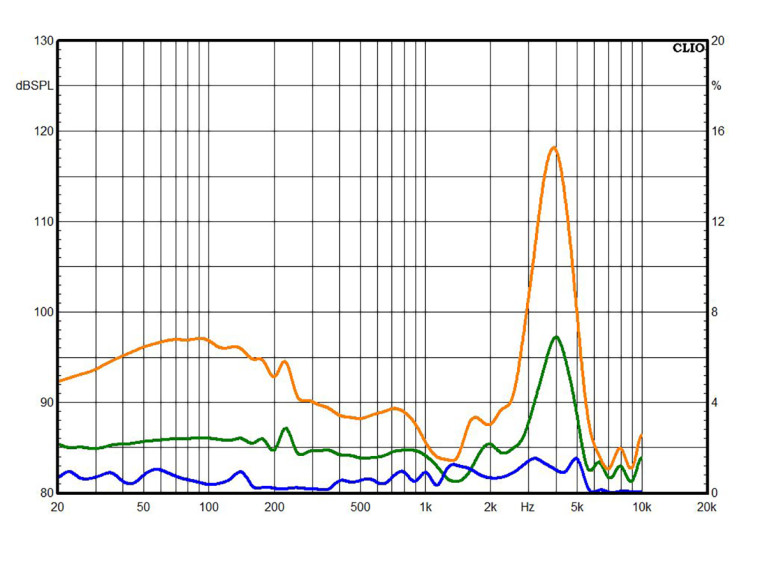
The rise we see here in distortion below 400Hz at 95dBA isn’t that unusual, but the large distortion peak centered at 4kHz is. (These are average figures; as usual distortion varied with each sweep, so these are the most “middle of the road” of the 10 sweeps I tried at each level.) When testing distortion of active headphones, it’s difficult to separate the performance of the amplifier from the performance of the driver, but I have to suspect this anomaly is coming from the driver, as I’ve never seen an amp produce such a distinct distortion spike, at least not within its normal operating range. I also included the 100dBA measurement of the EarFun Free 2, an inexpensive true wireless earphone, for reference.
Knowing that balanced armatures are rarely, if ever, used for noise-cancelling applications because their bass output is inadequate (noise-cancelling earphones with balanced armatures tend to use a dynamic driver for the bass), I ran some 100Hz sine-wave distortion measurements of the Megaclite plus the Campfire and AKG earphones previously noted. THD at 100dB and 110dB, respectively, was 0.143% and 0.618% for the Megaclite, 0.349% and 0.508% for the Campfire Satsuma (again, a balanced-armature model) and 0.129% and 0.405% for the AKG (a dynamic-driver model). Both passive models were driven by the headphone output of the Realtek audio system in my laptop.
Although the Megaclite’s distortion was the highest of the bunch at 110dB, the margin wasn’t large, and the fact that it came close to the dynamic earphone’s performance at 100dB is encouraging — especially considering that the driver in the Megaclite is one of USound’s first-generation MEMS speakers, while the drivers in the other earphones have been through countless generations and a few decades of refinement. So there’s hope that single MEMS drivers might someday be up to use in noise-cancelling earphones.
Conclusion
Based on what I heard and measured from the Megaclite, I have no doubt that a MEMS driver can deliver sound quality that’s competitive with dynamic-driver and balanced-armature earphones. It’s likely that most earphones employing these drivers will include DSP, which should make it easy to tune out the few anomalies I heard and measured — as easy as it would be with dynamic drivers, I expect.
I will be curious to see how well these drivers integrate into typical active earphone systems, and if their power demands and distortion performance will be adequate to the task. But considering that this is a first-generation product, I think the results are promising, and I’m eager to see how earphone manufacturers can take advantage of the size, ruggedness, and practicality of these new drivers.
This article was originally published in audioXpress, October 2021.
 About the Author
About the AuthorBrent Butterworth has been a professional audio journalist since 1989, and has measured and evaluated thousands of audio products. His headphone measurements and reviews currently appear on soundstage.com and wirecutter.com. He has served as editor-in-chief of Home Theater and Home Entertainment magazines, contributing technical editor for Sound & Vision magazine, senior editor of Video magazine, and reviews editor of Windows Sources magazine. He has also worked as marketing director for Dolby Laboratories, and as a consultant on the design and tuning of speakers, subwoofers, and headphones.



